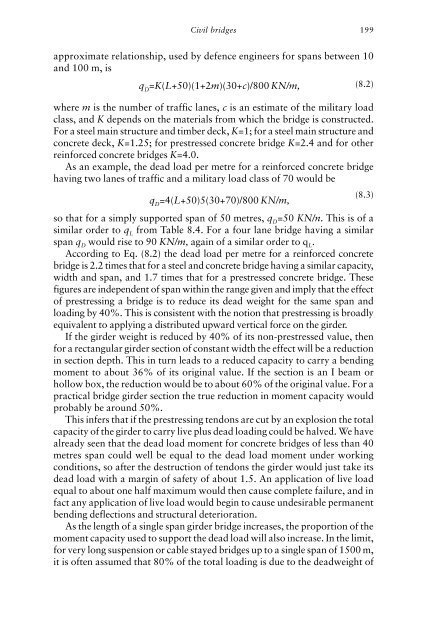A History of Research and a Review of Recent Developments
A History of Research and a Review of Recent Developments
A History of Research and a Review of Recent Developments
Create successful ePaper yourself
Turn your PDF publications into a flip-book with our unique Google optimized e-Paper software.
Civil bridges 199<br />
approximate relationship, used by defence engineers for spans between 10<br />
<strong>and</strong> 100 m, is<br />
q D =K(L+50)(1+2m)(30+c)/800 KN/m,<br />
(8.2)<br />
where m is the number <strong>of</strong> traffic lanes, c is an estimate <strong>of</strong> the military load<br />
class, <strong>and</strong> K depends on the materials from which the bridge is constructed.<br />
For a steel main structure <strong>and</strong> timber deck, K=1; for a steel main structure <strong>and</strong><br />
concrete deck, K=1.25; for prestressed concrete bridge K=2.4 <strong>and</strong> for other<br />
reinforced concrete bridges K=4.0.<br />
As an example, the dead load per metre for a reinforced concrete bridge<br />
having two lanes <strong>of</strong> traffic <strong>and</strong> a military load class <strong>of</strong> 70 would be<br />
q D =4(L+50)5(30+70)/800 KN/m,<br />
(8.3)<br />
so that for a simply supported span <strong>of</strong> 50 metres, q D=50 KN/n. This is <strong>of</strong> a<br />
similar order to q L from Table 8.4. For a four lane bridge having a similar<br />
span q D would rise to 90 KN/m, again <strong>of</strong> a similar order to q L.<br />
According to Eq. (8.2) the dead load per metre for a reinforced concrete<br />
bridge is 2.2 times that for a steel <strong>and</strong> concrete bridge having a similar capacity,<br />
width <strong>and</strong> span, <strong>and</strong> 1.7 times that for a prestressed concrete bridge. These<br />
figures are independent <strong>of</strong> span within the range given <strong>and</strong> imply that the effect<br />
<strong>of</strong> prestressing a bridge is to reduce its dead weight for the same span <strong>and</strong><br />
loading by 40%. This is consistent with the notion that prestressing is broadly<br />
equivalent to applying a distributed upward vertical force on the girder.<br />
If the girder weight is reduced by 40% <strong>of</strong> its non-prestressed value, then<br />
for a rectangular girder section <strong>of</strong> constant width the effect will be a reduction<br />
in section depth. This in turn leads to a reduced capacity to carry a bending<br />
moment to about 36% <strong>of</strong> its original value. If the section is an I beam or<br />
hollow box, the reduction would be to about 60% <strong>of</strong> the original value. For a<br />
practical bridge girder section the true reduction in moment capacity would<br />
probably be around 50%.<br />
This infers that if the prestressing tendons are cut by an explosion the total<br />
capacity <strong>of</strong> the girder to carry live plus dead loading could be halved. We have<br />
already seen that the dead load moment for concrete bridges <strong>of</strong> less than 40<br />
metres span could well be equal to the dead load moment under working<br />
conditions, so after the destruction <strong>of</strong> tendons the girder would just take its<br />
dead load with a margin <strong>of</strong> safety <strong>of</strong> about 1.5. An application <strong>of</strong> live load<br />
equal to about one half maximum would then cause complete failure, <strong>and</strong> in<br />
fact any application <strong>of</strong> live load would begin to cause undesirable permanent<br />
bending deflections <strong>and</strong> structural deterioration.<br />
As the length <strong>of</strong> a single span girder bridge increases, the proportion <strong>of</strong> the<br />
moment capacity used to support the dead load will also increase. In the limit,<br />
for very long suspension or cable stayed bridges up to a single span <strong>of</strong> 1500 m,<br />
it is <strong>of</strong>ten assumed that 80% <strong>of</strong> the total loading is due to the deadweight <strong>of</strong>


